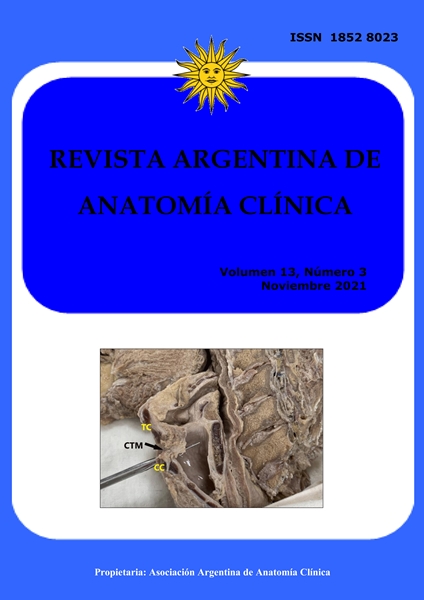MIRADA ANATÓMICA DE LA VÍA OLFATORIA Y SU RELACIÓN CON EL TÁLAMO
DOI:
https://doi.org/10.31051/1852.8023.v13.n3.34736Palabras clave:
Núcleo mediodorsal; corteza entorrinal; olfato.Resumen
El sistema olfatorio es aquel encargado de la recepción de estímulos sensitivos vinculados al olor de las sustancias. Su vía comienza en las células bipolares de “Schultze” en la mucosa olfatoria y finaliza en la corteza olfativa primaria, que abarca corteza piriforme, y a la corteza orbitofrontal. Las demás estructuras cerebrales olfativas incluyen la corteza entorrinal, el hipocampo, corteza parahipocampal, el tálamo, el hipotálamo, la corteza orbitofrontal, la corteza insular y su extensión hacia la región frontal lateral inferior. El tálamo es un núcleo encefálico que cumple una vital función de regulación sensitiva del organismo interviniendo en una gran cantidad de procesos mentales que dan forma a la manera de percibir y actuar en el entorno. Durante mucho tiempo se pensaba que el tracto olfatorio no guardaba relación con el tálamo, esto se debió al concepto del bulbo olfatorio como su propio equivalente talámico. Sin embargo, las aseveraciones más vigentes demuestran que el núcleo mediodorsal del tálamo presenta numerosas conexiones con las diferentes estructuras olfatorias que participan en la discriminacion y aprendizaje del olfato. Si bien estas interacciones implican una función clara del tálamo, no se trata de una proyección esencial para esta vía. El equivalente talámico, las interconexiones de las interneuronas granulares y periglomerulares del bulbo olfatorio acompañada de su conexión cortical son más que suficientes para el correcto funcionamiento de la vía olfatoria.
Referencias
Adair D, Truong D, Esmaeilpour Z, Gebodh N, Borges H, Ho L, Bremner JD, Badran BW, Napadow V, Clark VP, Bikson M. 2020. Electrical stimulation of cranial nerves in cognition and disease, Brain Stimulation 13: 717-50.
Barrett KE, Barman SM, Boitano S, Brooks HL. 2016. Ganong, Fisiología Médica. 25ª edición, España: Editorial McGraw-Hill, pág: 218-19.
Bay HH, Cavdar S. 2013. Regional connections of the mediodorsal thalamic nucleus in the rat. Journal of integrative neuroscience 12: 201–19.
Courtiol E, Wilson DA. 2015. The olfactory thalamus. unanswered questions about the role of the mediodorsal thalamic nucleus in olfaction. Frontiers in neural circuits 9: 49.
Guillery RW. 1995. Anatomical evidence concerning the role of the thalamus in corticocortical communication: a brief review. Journal of anatomy 187: 583–92.
Hall JE. 2016. Guyton y Hall: Compendio de fisiología médica. 13a Edición, España: Editorial Elsevier, pag: 688-89.
Krettek JE, Price JL. 1977. The cortical projections of the mediodorsal nucleus and adjacent thalamic nuclei in the rat. The Journal of comparative neurology 171: 157–91.
Ongür D, Price JL. 2000. The organization of networks within the orbital and medial prefrontal cortex of rats, monkeys and humans. Cereb Cortex 10: 206-19.
Potter H, Butters N. 1980. An assessment of olfactory deficits in patients with damage to prefrontal cortex. Neuropsychologia 18: 621–28.
Price JL, Slotnick BM. 1983. Dual olfactory representation in the rat thalamus: an anatomical and electrophysiological study. The Journal of comparative neurology 215: 63–77.
Price JL, Slotnick BM, Revial MF. 1991. Olfactory projections to the hypothalamus. The Journal of comparative neurology 306: 447–61.
Sarnat HB, Flores-Sarnat L. 2019. Development of the human olfactory system. Handbook of clinical neurology 164: 29–45.
Shepherd GM. 2005. Perception without a thalamus how does olfaction do it?. Neuron 46: 166–68.
Splittgerber R. 2019. Snell Neuroanatomía Clínica. 8ª Edición, España: Editorial Wolters Kluwer, pág: 367.
Wang J, Eslinger PJ, Smith MB, Yang QX. 2005. Functional Magnetic Resonance Imaging Study of Human Olfaction and Normal Aging. The Journals of Gerontology Series A 60: 510–14.
Waxman SG. 2011. Neuroanatomía clínica. 26ª Edición, España: Editorial McGraw-Hill, pág: 229.
Descargas
Publicado
Número
Sección
Licencia
Derechos de autor 2021 Melisa S. Gonzalez Abad, Juan A. Costa, Matias A. Perea, Gaston Tarantino

Esta obra está bajo una licencia internacional Creative Commons Atribución-NoComercial 4.0.
Los autores/as conservarán sus derechos de autor y garantizarán a la revista el derecho de primera publicación de su obra, el cuál estará simultáneamente sujeto a la Licencia de reconocimiento de Creative Commons que permite a terceros compartir la obra siempre que se indique su autor y su primera publicación en esta revista. Su utilización estará restringida a fines no comerciales.
Una vez aceptado el manuscrito para publicación, los autores deberán firmar la cesión de los derechos de impresión a la Asociación Argentina de Anatomía Clínica, a fin de poder editar, publicar y dar la mayor difusión al texto de la contribución.



